Menu
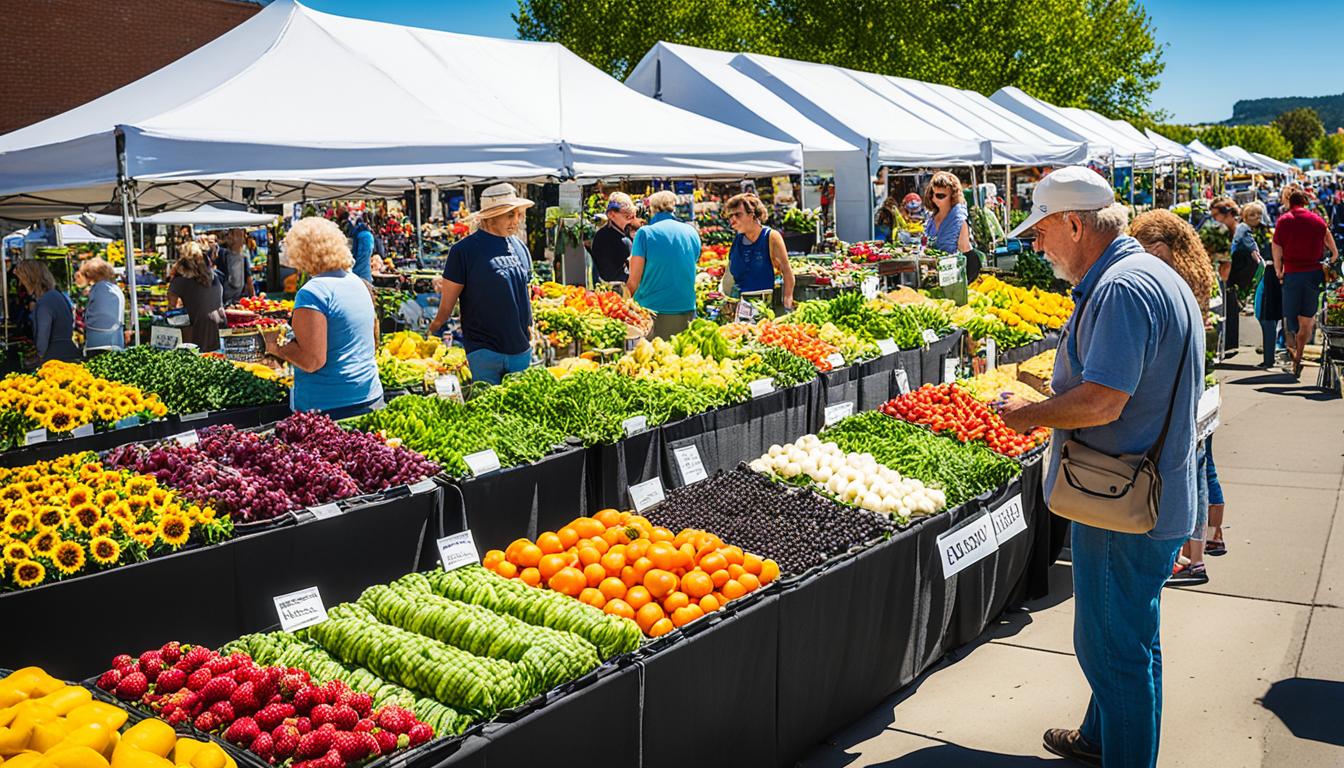
Did you know around half of farmers markets sell items with organic labels? It’s amazing and shows how important farmers markets are. They help promote farming that’s good for the earth and let us buy fresh, local, organic food. This dedication to organic farming is clear. There are many fruits, vegetables, and other goods you can buy. Plus, the people who grow them use methods that are good for the planet.
Farmers markets are a key link between farmers and those of us wanting to eat well. They help local farmers, who often use ways of farming that don’t harm the environment. These markets often sell food that’s come from farms less than 200 miles away. This helps cut down on how much pollution is made. Most farmers—about 75%—use methods that are like those used for organic food. And a big 81% also take steps to keep the soil healthy. It’s no wonder more people are turning to farmers markets for their organic food needs.
Food from far away has to travel a long way, sometimes over 1,000 miles, to reach us. On the other hand, food from farmers markets doesn’t have to go very far, about 27 times less. This big difference is why buying food from local farmers helps our community and the earth. It also supports a way of farming that lasts longer and meets the growing interest in organic food.
Farmers markets are key to promoting organic food. They connect local farmers directly to consumers. This allows people to buy fresh, locally grown organic produce that meets high standards.
Think of farmers markets as gathering spots for communities. They let local producers and farmers sell their goods straight to buyers. These markets show the path from farm to table, supporting small and mid-sized farms.
Local farmers markets ensure you get fresh, sustainable goods. They help consumers and farmers alike. Plus, they play a big role in supporting the local economy and the community’s health.
Farmers markets are where you can find a variety of fresh items. They sell everything from fruits and vegetables to baked goods and meats. By doing so, they help small businesses and improve community life with better food access.
At these markets, organic produce means food grown a certain way. That is, without synthetic chemicals, GMOs, or irradiation. This way of farming is good for the environment and for our health.
For a farm to be organic, it must follow strict USDA rules. While small farms don’t need certification if they sell less than $5,000 a year, most do. The USDA even helps with certification costs up to 75% or $750 per category.
Breaking these rules can lead to big fines. To protect consumers, USDA asks people to report any suspicious organic claims. The goal is to ensure the label’s trustworthiness.
The USDA also educates and trains those in the organic industry. This helps everyone follow the same high standards. They do this through the Organic Literacy Initiative. It shows how serious USDA is about organic integrity.
The demand for organic food is shooting up. In the last ten years, the industry has grown a lot. This is because people are now more aware of the benefits of organic food and its positive impact on health and the planet.
This change in thinking has led to a big increase in organic food sales. Now, more people buy organic fruits and vegetables from not just farmers markets but also from big supermarkets. The rise of this trend shows that more and more families are choosing fresh organic food for their meals.
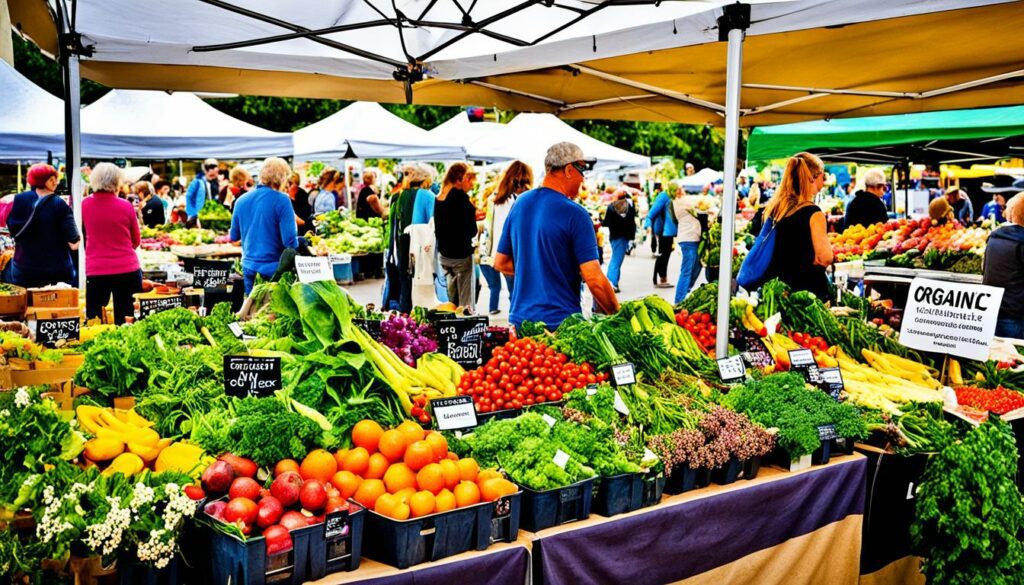
More people are now aware of organics, and this really matters. In 2016, more than 80% of American households bought organic food. It shows how much the idea of choosing organic has spread.
This move towards organic stuff is thanks to a lot of information being shared. People know that organic farming avoids harmful chemicals and is good for the earth. As a result, sales of fresh organic fruits and veggies hit $19.2 billion in 2021.
The numbers for organic food sales keep getting better. Each year, they go up by 8%. This growth has brought us to a total of over $52 billion in sales in 2021. Most of this buying happens in regular and natural food stores, showing it’s easy for people to find organic options.
More farms are turning organic too, with over 17,000 now certified. This growth on the farm matches the increased demand. Plus, buying organic online is becoming more popular, making it simple for anyone to shop organic.
| Year | Organic Cropland (million acres) | Certified Operations | Retail Sales (billion USD) |
|---|---|---|---|
| 2011 | 2.01 | ~9,172 | ~30.5 |
| 2021 | 3.6 | 17,445 | 52 |
The rise in interest in organic food comes from a mix of reasons. People want to eat healthier, and they have more information now. Also, it’s easier than ever to find organic products. All of this is leading to a steady growth in the organic food market.
Farmers markets are vital for promoting green farming and reducing food miles. They help lower the impact on our planet and boost sustainable farming among local producers.
Farmers markets are hubs for green farming. A 2015 survey found that 48% use integrated pest management. Also, 81% use cover crops, reduce tilling, and do on-site composting. These methods cut back on chemical use, improve soil health, and increase biodiversity.
About 1 in 4 farmers at these markets meet organic standards, showing a big commitment to eco-friendliness.
Farmers markets help cut food miles significantly. Food in the U.S. often travels over 1,000 miles to get to stores. But, markets sell produce from within 200 miles. This cuts down on greenhouse gas emissions and means fresher, healthier food for people to buy.
| Distance Traveled | Conventional Stores | Farmers Markets |
|---|---|---|
| Average Distance (miles) | 1,000+ |
Vermont’s research found that organic food at markets is usually cheaper than in supermarkets. Thus, it makes it easier for everyone to choose eco-friendly food. Buying local also cuts air pollution and lessens the environmental cost of food travel, supporting sustainable farming.
Farmers markets are a great place for green practices, promoting eco-friendly farming and reducing food miles greatly.
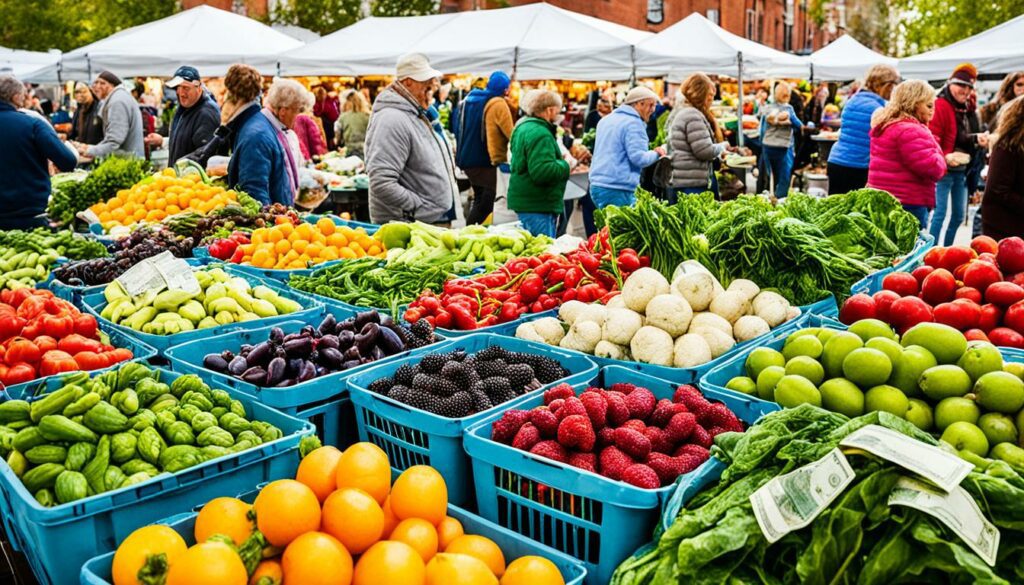
The economic impact of farmers markets is vital for local areas. They help communities and farmers. These markets offer fresh, organic food and boost the economy.
These markets are key for local finances. With over 8,000 markets, they keep money local. For instance, Florida saw $1.8 billion spent at markets in one year. This shows their direct benefit. In Pennsylvania, the Easton Farmers Market saw a boost in local spending from its customers.
Also, spending at markets helps other shops. People spend between $0.58 and $1.36 more locally after visiting markets. This ripple effect is good for many businesses.
Farmers gain a lot from markets. In 2012, they sold $1.3 billion directly to customers. This helps keep more money in the local area. Each dollar of sales creates more local economic activity for these farmers.
It’s good for jobs too. For every $1 million earned, these farms provide 32 local jobs. This beats the 10.5 jobs from bigger farmers. South Carolina and Wyoming are just two places that show how farmers markets support jobs and local income.
| Statistic | Description |
|---|---|
| $16 million | SNAP redemptions at farmers markets in 2012 |
| 8,761 | Number of farmers markets in the US (2019) |
| 21% | Markets operating year-round (2019) |
| 65% | Markets registered as nonprofit (2019) |
| $711 million | Total revenue from direct-to-consumer farm sales (2015) |
| $11.7 billion | Local food sales from farmers markets (2014) |
The farm-to-table movement really helps. It’s more than a fashion. It supports local economies and farmers. This makes for stronger communities and better food systems.
The farm-to-table movement is quickly becoming a top food trend in the U.S. It started with the 1960s and 1970s West Coast hippie movement. Now, it’s all about connecting farmers directly with people who eat their food. This connection is built on being open and caring for the environment.
This movement is making farmers and eaters closer. People can now know exactly where their food comes from. They also learn about how it’s made. This interest helps local communities and farmers. For example, schools work with local farms to give kids fresh food.
Going organic is a big change because of this movement. People are more interested in knowing how their food is made. They like to choose food that is good for the planet. Because of this, there are more local farmers at markets and more places offer farm-to-table food. This helps the food industry become more healthy and friendly to the environment.
Getting organic certification is a strict process. It’s run by the USDA. They ensure the food meets high ecological and health standards. The organic certification process requires hard work and a lot of money from producers and handlers.
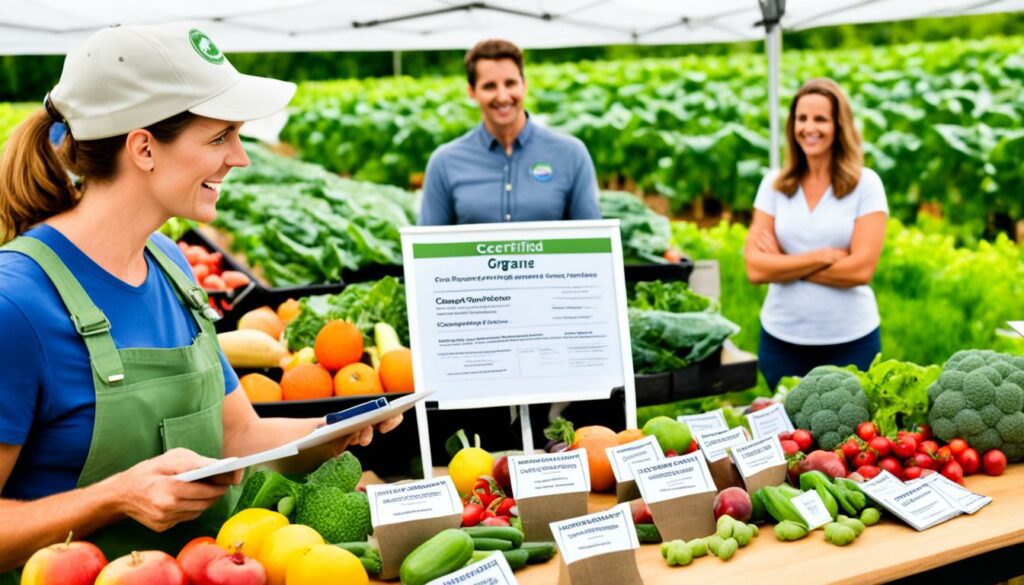
The USDA organic standards are very clear. They say no to synthetic fertilisers, pesticides, GMOs, and irradiation. Farms should also treat animals well. This helps nature and the animals to keep balance.
The certification happens in five stages:
Every year, farms get a detailed check to keep their organic label. This makes sure they keep following the rules.
Although getting certified is good, it’s tough for some farmers. One main problem is the cost. It can be a lot, starting from around $350 for the application.
Another challenge is the long wait, up to 36 months, to transition to organic land. This means they can’t sell products as organic until then. This affects their income.
But, there is help. The USDA offers to pay up to 75% of the cost for some. This can make it easier for farmers. Plus, the USDA offers to help with advice and money during the waiting time.
There are many guides for farmers wanting to go organic. They help with growing crops, raising animals, or processing food. Also, agencies like CCOF provide help throughout the certification process.
The USDA wants more people to think about going organic. They teach new farmers and ranchers through the Organic Literacy Initiative. This helps people decide if organic farming is right for them. More and more farmers are choosing organic, making farming better for our planet.
Community farmers markets play a big role in local areas. They sell fresh organic food and help bring people together. These markets are more than just places to buy food. They are where people from the area meet and learn together.
These markets are essential for creating local connections. When people come to a farmers market, they join a special community. They meet others, talk, and start new friendships. Markets where sellers are closer to the buyers, like within 50 miles, help make these encounters more personal.
Farmers markets are rich in learning opportunities. About 80% of farmers talk to customers about their farming ways. And 75% use organic standards. People can learn about eco-friendly farming and pest control at these markets. This helps them become more aware and thoughtful shoppers.
| Statistic | Data |
|---|---|
| SNAP redemptions at farmers markets in 2012 | $16 million |
| Percentage of organic practices among surveyed farmers | 75% |
| Total farmers markets listed in the US | 8,000+ |
| Food travel distance for locally sourced produce | 27 times less than conventional produce |
Community farmers markets do more than sell goods. They create a space where ideas, traditions, and fresh organic food mix. This blend feeds both the body and the local spirit.
Farmers markets help in supporting eco-friendly farming practices. They connect consumers with producers who use responsible methods. This reduces harm to the environment. Also, it ensures that farming is both efficient and safe for the Earth.
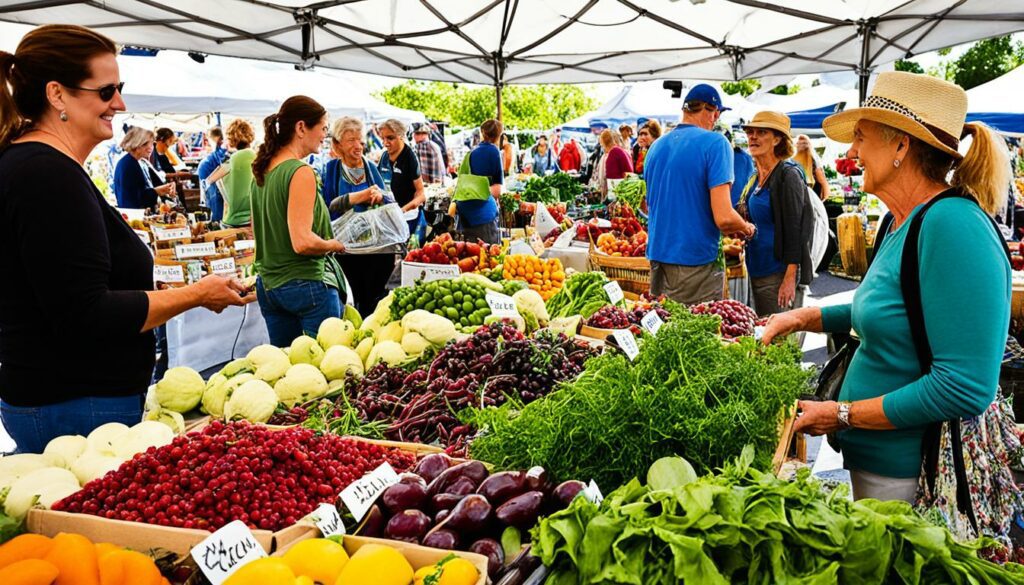
Farmers markets help in cutting down the distance food travels. It’s been shown that food travels more than 1,000 miles to get to stores. But, at these markets, food must come from within 50 to 200 miles away. This means food travels about 27 times less, reducing emissions and the environmental effect.
A 2015 survey discovered important details. One in four farmers protect their land from being turned into commercial zones. Also, three in four use methods that are like organic farming, such as managing pests without harming the environment. They take care of the soil and sell a variety of items like livestock, fruits, and nuts. Together, these actions help lessen farming’s environmental impact.
At markets, about 48% of farmers manage pests in eco-friendly ways. And 81% take care of the soil properly. These steps protect the soil and require fewer harmful chemicals. This supports practices that care for the Earth. Also, the wide range of products, from veggies to livestock, helps promote a rich variety in farming.
The markets encourage and celebrate sustainable methods. Vendors receive support from customers who value environmentally-friendly products. This shows the markets’ strong commitment to sustainable farming and protecting nature. They play a key role in moving towards a farming future that takes care of the planet.
| Aspect | Conventional Retail | Farmers Markets |
|---|---|---|
| Food Miles | 1,000+ miles | 50-200 miles |
| Pesticide Use | High | Low, many organic or pesticide-free |
| Product Diversity | Standard | High, includes livestock, poultry, and value-added products |
| Environmental Footprint | Large | Small |
Farmers markets are crucial for sustainable agriculture. They help reduce the impact on the environment. Plus, they support farming methods that protect our planet. This is part of their commitment to a green future in food production.
Visiting a local farmers market benefits both you and your community. One highlight is the fresh and nutrient-rich produce. This food is picked just before sale, so it’s full of goodness according to the United States Department of Agriculture.
These places help small-scale farmers. By buying their produce, you help the local economy. These farmers also use sustainable methods, meaning less harm from chemicals.
They also protect farmland and support a strong local food network. The American Farmland Trust says this backing keeps farming practices good for the earth and people.
Locally-grown foods from a farmers market also bring a bigger choice. This lets you try new tastes and eat more varied foods. It’s worth noting that the short food miles reduce the meal’s carbon footprint.
“On average, food travels over 1,000 miles from production to retail stores, whereas farmers markets often limit vendors to selling food produced within 50 to 200 miles.”
Additionally, nearly half of these markets offer certified organic food. And usually, these prices beat those at supermarkets. A Vermont study found that, except for potatoes, organic goods are cheaper at the market.
But more than just saving money, these markets build community bonds. They are places where people share the local harvest and boost the area’s economy. Shopping here means choosing a healthier life and helping your community.
| Aspect | Farmers Markets | Supermarkets |
|---|---|---|
| Freshness | High | Moderate |
| Support for Local Farmers | Direct | Indirect |
| Variety of Produce | Wide | Limited |
| Total Food Miles | Low (50-200 miles) | High (over 1,000 miles) |
| Organic Choices | Extensive | Available, but limited |
| Price Comparison | Often Competitive | Higher |
Farmers markets are the heart of getting fresh food straight from the farm to your table. They offer a rich selection of fruit, veg, meats, and artisan products. This makes it easy for people to choose organic over conventional.
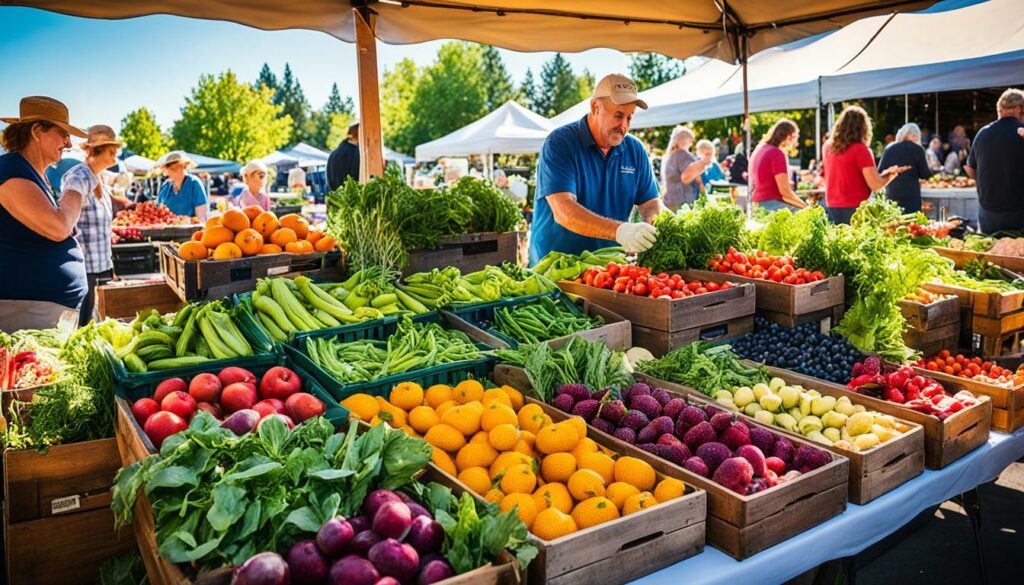
In summer, over 8,500 farmers markets across the US open their doors. They become lively places, drawing in crowds who seek fresh and organic foods. To shop wisely, take a lap first. This helps you spot the best deals and the highest quality items.
Choosing food that’s in season is wise because it tastes better and costs less. It’s crucial to arrive early to grab the finest selections before they’re gone. A big bag and eco-friendly produce bags are helpful. They make carrying your finds easy and help the planet too.
Knowing how to pick the ripest fruit and veg is a key skill. Use your senses to select the best items. Careful packing will stop your produce from getting squashed. Also, farmers markets are ideal for buying fresh flowers. They’re often better and cheaper than those at a store.
| Tips | Details |
|---|---|
| Early Arrival | Best produce sells out fast. |
| Avoid Impulse Buying | Do a full lap around the market first. |
| Seasonal Selection | More affordable and tastier options. |
| Widely Available Items | Better deals compared to out-of-season produce. |
| Smart Packing | Prevents bruising and wastage. |
Organic farmers face many hurdles, with big agribusinesses as their main competition. These big companies enjoy the benefits of size, economies of scale, and support from the government. This puts them ahead of smaller organic farms. So, the market is tough for these farmers.
Competing with giants in the industry is a big challenge for organic farmers. These big players have more resources and can reach more customers. Despite the organic food market growing, these big companies still have much power. They can get their supplies cheaper, making it hard for small farmers to do well.
Organic farming costs a lot to do. It needs a lot of work and careful planning, like using cover crops, something most non-organic farmers don’t do. Getting certified can also be expensive. Even with over $39 billion put into making it cheaper, the costs of doing organic farming hasn’t dropped much.
| Challenge | Impact on Organic Farmers |
|---|---|
| Competing with Large Corporations | They have a smaller part of the market because big companies are too dominant. |
| High Production Costs | Farms face big money troubles because of how they have to farm and get certified. |
These problems show why organic farmers need new, clever ways to compete and stay in business. Fixing these issues is key for organic food to keep growing. This market has been expanding by about 20% every year since the 1990s. So, helping organic farmers is important for the future of healthy food.
Many shoppers prefer organic produce because they believe it is better for health and the environment. Health and environmental benefits are big reasons for this choice.
People love organic food for its health advantages. It’s grown without harmful chemicals, making it a hit with those who are health aware. Italy shows that shoppers will pay more for fruit and veg that’s pesticide-free.
Organic fruits often have more nutrients than regular ones. This means they are even better for you. This is why many choose organic options.
The harm of usual farming methods is a main reason why organic is chosen. Organic farms help the earth by cutting pollution, saving water, and making soil better.
Comparing organically grown food with regular shows big nutritional differences. This is more evidence that organic growing is healthier for us and the planet.
People show they care about the planet by buying at farmers’ markets. Most choose food from Utah over foreign food. This shows growing awareness of food’s environmental effects.
Globally, there is a rise in choosing eco-friendly foods. Many go for organic to support this, as seen from The World of Organic Agriculture.
| Produce | Conventionally Grown Local | Organically Grown (Unknown Origin) | Conventionally Grown (Unknown Origin) |
|---|---|---|---|
| Green Peppers | 61% | 26% | 13% |
| Cucumbers | 66% | 25% | 9% |
At farmers’ markets, local produce wins out, whether organic or not. 61% go for local, regular green peppers, showing a strong preference. Also, 66% like local cucumbers that are not organic more than organic ones. This is a sign of trust in local farming and its benefits.
Buying local is seen as good for personal health and the environment. This is why many go for local options.
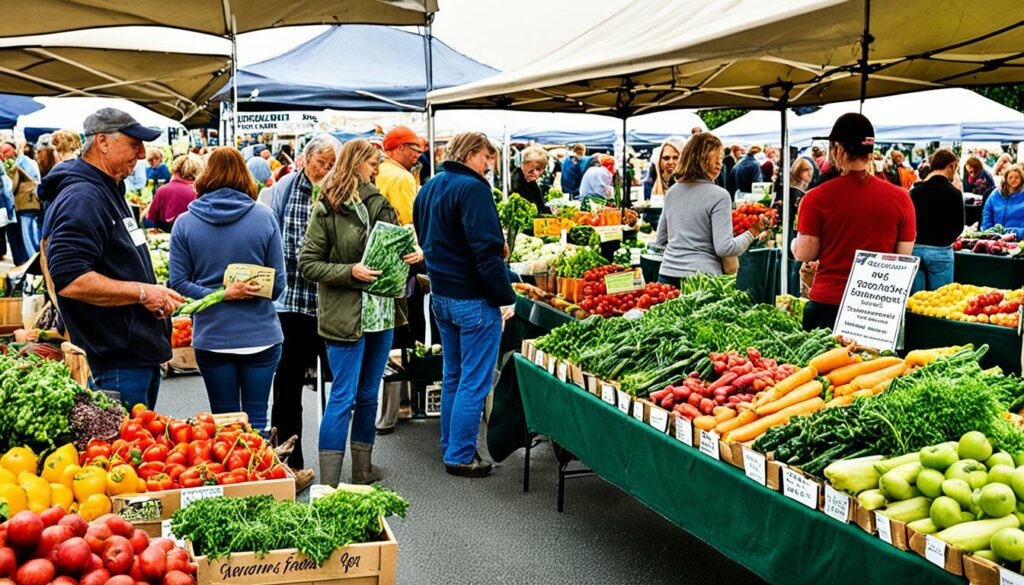
Consumers choose organic food for important reasons. These include personal health and wanting to reduce harm to the planet. Farmers’ markets play a key role in meeting this demand.
Buying seasonal local produce at farmers markets is good for both sellers and buyers. It helps create a vibrant and lasting food environment. Nearly half of these markets offer organic produce. Also, they often have items that are free of chemicals. This draws people in with the promise of fresh, nutritious food.
One big plus of seasonal food is its freshness and health benefits. Since it follows nature’s own timetable, it tastes the best and is packed with nutrients. A study in Vermont found that organic food at farmers markets is usually cheaper than at stores, except for potatoes. This lower price makes good, seasonal food available to more people, which supports the environment.
Seasonal goods typically travel about 200 miles to get to the markets. This is much less than the 1,000-plus miles that regular food travels. So, the local option is much better for the planet. Also, food from nearby sources travels 27 times fewer miles than regular food. To learn more about why you should pick seasonal food at farmers markets, check out the Farmers Market Coalition’s site.
However, there are challenges with having food that is seasonal. It is hard for farmers to keep a steady supply, especially in the off-seasons, when fewer things grow. This can make the public’s interest and market visits change during the year.
People’s needs also change with the seasons. Farmers must be ready to adjust and teach their customers about the ups and downs of eating with the seasons. In a 2015 study, 80% of farmers said they talked to their customers about how they farm. This helps everyone understand what to expect in terms of available produce and its quality.
| Produce | Percentage of Farmers |
|---|---|
| Vegetables | 69% |
| Livestock/Poultry | 53% |
| Fruits and Tree Nuts | 47% |
| Value-Added Products | 31% |
Various products are found at farmers markets. But, their type and amount change with the seasons. Mixing challenges with good communication and flexible farming keeps the local, seasonal food scene lively and successful.
Farmers markets show off a wide range of organic produce. About half of these markets sell items with organic labels. A study in Vermont found that organic items were often cheaper at markets than nearby stores.
This makes them a great option for those who want to eat healthily without spending too much. Local vendors at these markets can then offer top-quality organic goods at fair prices.
One big plus of farmers markets is they reduce food miles. Food usually travels over 1,000 miles to get to us. But, many local markets only allow food from within 200 miles. Some go even further, only accepting food from 50 miles away. This cuts down on harm to the environment.
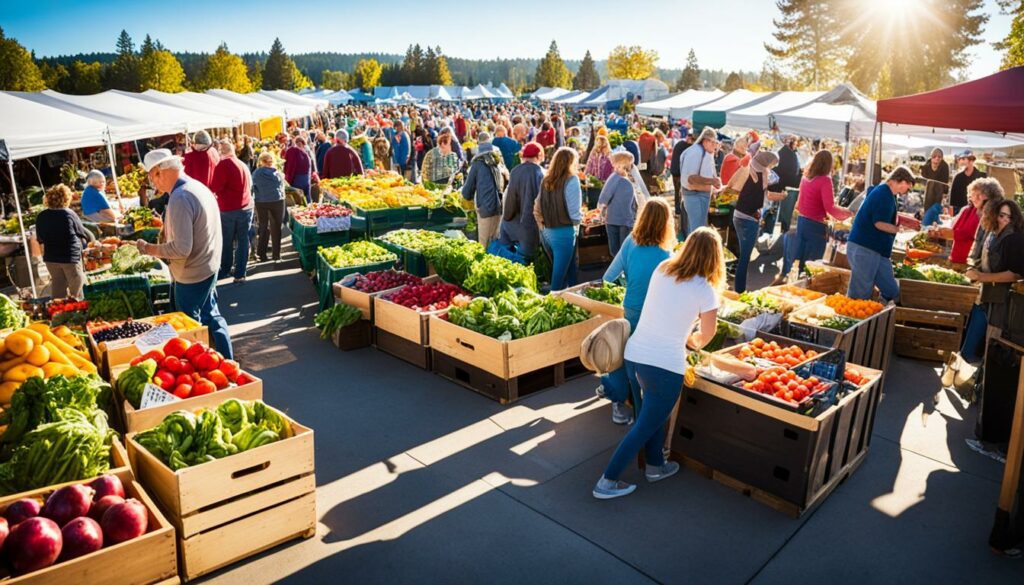
In 2015, a study showed how much farmers care about organic methods. Three out of four farmers follow such practices. Nearly half use methods to control pests naturally, and 81% look after the health of the soil.
They sell lots of stuff, too. Most sell veggies, half sell meat, and nearly half offer fruits. A good chunk also sells products that add value to these foods. This selection shows the abundance of organic foods at farmers markets.
Places like the Tuesday Farmers Market at Tacketts Mill Dr in Lake Ridge, VA, are great examples. They are part of a movement that supports eco-friendly farming. Plus, they help their communities stay healthy by providing fresh, organic food.
Local initiatives are key to strong organic farmers markets. They bring together government support for organic farming and community programs for sustainability. This mix helps build a solid base for these markets to grow.
Help from the government is vital for organic farmers markets. They offer financial help like grants and subsidies to lower farmers’ costs. An example is the Rescued Organics program in California. It shows a variety of local produce from organic farmers.
The government also teaches farmers about organic practices and helps them earn certifications. This support makes it easier for farmers to meet the growing demand for organic products.
Community support is crucial for these markets too. Local programs boost the economy by encouraging people to shop locally. The NC 10% Campaign proves that spending money at local stores has a big impact within the community.
In North Carolina, CSAs and websites like MeatSuite.com help bring consumers closer to local farmers. They buy fresh farm products and support the local food system. Volunteering at farms and gardens is another way people can help keep the community system running.
| Aspect | Details |
|---|---|
| Farmers Implementing Organic Practices | Three out of every four farmers use organic-consistent practices. |
| Soil Health Practices | 81% of farmers incorporate soil health practices. |
| Locally Sourced Produce Travel | Locally sourced produce travels 27 times less distance than conventional produce. |
| Sprouts Farmers Market Initiative | Rescued Organics program features 12 different types of local produce. |
Together, government support for organic farming and community programs for sustainability ensure the success of local organic markets. They help meet the goals of protecting the environment and supporting the economy.
Farmers markets play a big part in eco-friendly, community, and economy. They help protect the environment and give us better food choices. When we shop there, we lower the pollution caused by long food journeys.
Buying from these markets supports local workers and boosts rural economies. It helps in avoiding excess waste and keeps our food safe. This way, we make a positive impact.
At these markets, you find the best fresh fruit and veg because you meet the people who grow them. You learn a lot from farmers about natural methods. This way, you don’t just get healthier food; you also help the planet.
These markets are always trying to overcome difficulties. They face bad weather or money problems, but they keep going strong. This shows their importance for our future.
So, farmers markets are key to a better food and farming future. They connect what we want with what’s good for the Earth. As more people care about the planet, these markets become even more crucial.
Farmers markets are key in helping us live sustainably. They give us direct access to fresh, locally-grown organic food. This supports farmers who use eco-friendly methods. It also connects us with quality produce that’s good for the earth.
A farmers market is a place where local farmers sell what they’ve grown to people nearby. It’s all about getting food from the field to your table, often without harmful chemicals. Here, you can find organic and locally sourced items.
Organic means food grown without man-made chemicals or genetic modification. It avoids things like sewage sludge and anything that’s been irradiated. The organic label tells us it’s made with care for the environment.
More people care about their health and the planet. They are learning about the benefits of organic food. This makes them look for it at farmers markets. So, the market for organic food is getting bigger.
Farmers at markets often use eco-friendly ways to grow food. This includes avoiding harmful chemicals and managing pests naturally. They also compost on-site, which is good for the environment.
They help local farmers make money by selling directly to people. This boosts the local economy and creates jobs. It keeps money and food production close to home,
Farm-to-table means knowing where your food comes from. It builds trust and friendship between those who grow food and those who eat it. Farmers and consumers both care more about how food is made.
The USDA checks farming practices to make sure they’re good for the planet. Farmers must follow strict rules, like not using certain chemicals. They also ensure livestock is treated well.
Community markets bring people together and teach them about farming in a better way. They are places to learn and have fun. Everyone works together to support a healthy way of growing food.
They show and sell foods grown in ways that protect the environment. For example, these farmers do not use as many chemicals. They also do things like planting special crops to keep the soil healthy.
Local markets offer numerous benefits. They help farmers sell their products directly. They also support the local economy and make the community stronger. Plus, the food is fresher and saves on how far it travels, showing the value of getting food from local sources.
Organic farming is not easy. Big companies can be tough competition. Plus, it costs a lot to grow food without chemicals. Rules for being organic are also quite strict.
People love organic food for its health and eco benefits. It shows a deep care for the environment. This is why farmers markets are important as they meet the need for real organic food.
Seasonal food means enjoying what’s best each time of the year. It’s good for you and the planet. Yet, it can be tricky to keep enough in stock and meet everyone’s expectations.
Local groups and government help farmers markets grow in a healthy and green way. They offer money and advice, making sure these markets thrive. This help is key for their future.